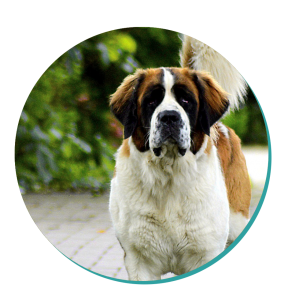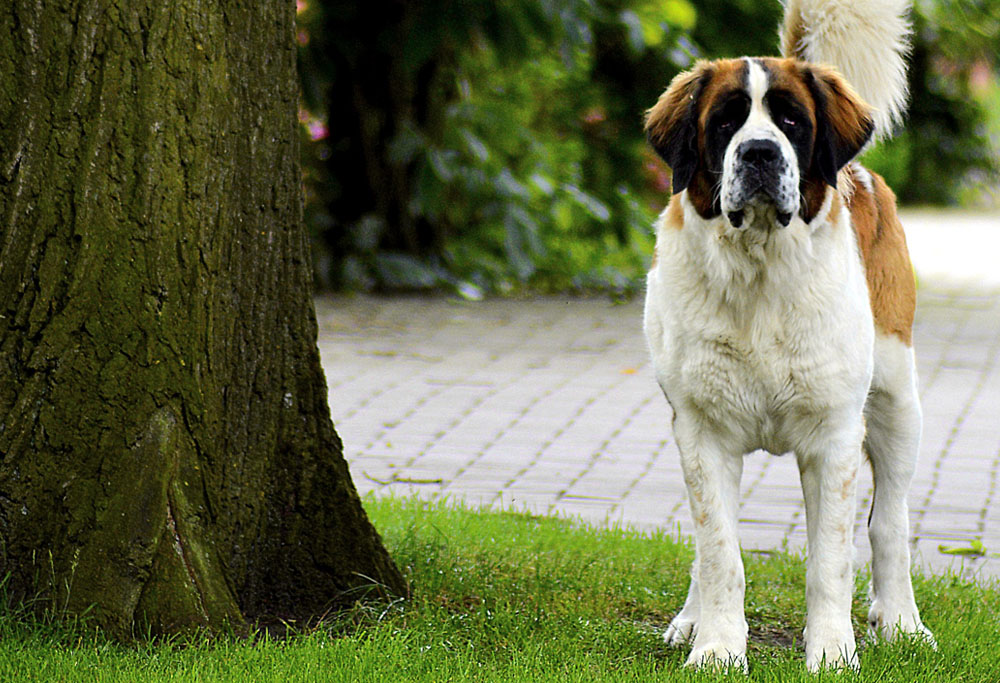In this month’s Dog Breed Corner, we lay out an extra-large welcome mat for the Saint Bernard! Check out the Saint Bernard’s origins, personality, trainability, grooming needs and more!
 Quick Facts ✔
Quick Facts ✔
Height – 65 – 90 cm
Weight – 64 – 120kg
Lifespan – 8 – 10 years
Country of origin – Switzerland
Breed type – Working Dog
- Owners looking for a constant canine companion
- Families with children
- Owners looking for an indoor dog
Breed History ♜
The roots of the Saint Bernard breed stem from Switzerland over a millennium ago. However, it was in the 18th century, near the high-altitude Swiss-Italian border, that the breed earned its rep. The dog was kept and bred by monks who ran a hospice in the treacherous Saint Bernard Pass. Originally raised as guard dogs, the Saint Bernards soon began to join the monks on their alpine rescue missions. Before long, the monks realised their large frames, thick coats, keen noses, and loyal temperaments made them ideal rescue dogs. For countless travellers stranded by a snowstorm in the Pass, these dogs meant the difference between life and death.
During the early 19th century, England and Germany began to import the breed. It wasn’t until 1880 that the breed was officially recognised as the “Saint Bernard” by the Swiss Kennel Club.
Personality Traits & Trainability ★
At their best, the Saint Bernard is a living tribute to the term “gentle giant”. They are a calm, patient breed, and will remain loyal to a loving Owner ’til the very end. While a Saint Bernard puppy will whiz around your home like a furry pinball, an adult will usually maintain a calm and relaxed demeanour. They read emotional cues like they’re flash cards, and will make it their goal to cheer you up. They’re also attuned to the needs of children, and will gladly take on the role of “furry ward”. Just be careful with toddlers; the Saint Bernard can grow so large they may bowl over smaller humans by mistake!
All of this gentle sensitivity has a flip side, however. The Saint Bernard depends on constant companionship to feel loved and fulfilled. If they’re left on their own for a period of several hours or more, they’ll come to feel depressed or destructive. To ensure they don’t develop destructive habits, always leave them with a family member or Dog Sitter when you’re out.
Due to their bulk, the Saint Bernard doesn’t require the rigid exercise regime of the Border Collie or the German Shepherd. Having said that, you will need to take them for a good stroll every day to keep them healthy. Since they are working dogs at heart, they’ll be at their happiest if they’re pulling a pram, sled, or luggage. As an added bonus, you’ll get to enjoy a break from pushing or carrying something.
When it comes to training, the Saint Bernard responds best to praise and motivation. In other words, keep those treats handy when you’re teaching them to sit!
Living Conditions ⌂
While the Saint Bernard doesn’t require a large amount of space to roam, they do occupy a large amount of space. As such, they can come to feel cramped and agitated in more confined quarters.
Conversely, the Saint Bernard is not an outdoor dog. The prospect of being left on their own in a sprawling backyard is not their idea of a good day. For optimum results, skip the yard and give your Bernie a spacious living room.
They will also struggle in warmer weather. If you live in a hotter climate, you’ll need to keep the A.C. blasting lest your Bernie overheat.
Grooming ✄
There are few dog breeds around that produce as much slobber as the Saint Bernard. Thanks to their winter heritage, they’re also heavy shedders. You can expect a “mass shedding” twice a year, but will also find clumps of hair on a regular basis. Hey, look on the bright side: come winter time, you’ll be living with a giant hot water bottle!
Fun Fact ♥
These days, Saint Bernards no longer work as rescue dogs in the Swiss-Italian alps. However, over the three hundred years in which they served, they were responsible for saving over 2,000 lost travellers. During this era, Saint Bernards would carry a small keg of wine around their neck. This wine would sustain those in need until the monks could arrive to whisk them back to the hospice.

